Focal adhesion kinase controls cellular levels of p27/Kip1 and p21/Cip1 through Skp2-dependent and -independent mechanisms
- PMID: 16705171
- PMCID: PMC1489078
- DOI: 10.1128/MCB.01612-05
Focal adhesion kinase controls cellular levels of p27/Kip1 and p21/Cip1 through Skp2-dependent and -independent mechanisms
Abstract
Endothelial cell proliferation is a critical step in angiogenesis and requires a coordinated response to soluble growth factors and the extracellular matrix. As focal adhesion kinase (FAK) integrates signals from both adhesion events and growth factor stimulation, we investigated its role in endothelial cell proliferation. Expression of a dominant-negative FAK protein, FAK-related nonkinase (FRNK), impaired phosphorylation of FAK and blocked DNA synthesis in response to multiple angiogenic stimuli. These results coincided with elevated cyclin-dependent kinase inhibitors (CDKIs) p21/Cip and p27/Kip, as a consequence of impaired degradation. FRNK inhibited the expression of Skp2, an F-box protein that targets CDKIs, by inhibiting mitogen-induced mRNA. The FAK-regulated degradation of p27/Kip was Skp2 dependent, while levels of p21/Cip were regulated independent of Skp2. Skp2 is required for endothelial cell proliferation as a consequence of degrading p27. Finally, knockdown of both p21 and p27 in FRNK-expressing cells completely restored mitogen-induced endothelial cell proliferation. These data demonstrate a critical role for FAK in the regulation of CDKIs through two independent mechanisms: Skp2 dependent and Skp2 independent. They also provide important insights into the requirement of focal adhesion kinase for normal vascular development and reveal novel regulatory control points for angiogenesis.
Figures
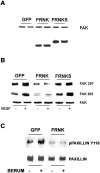


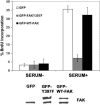

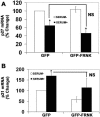
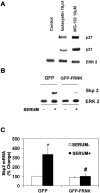
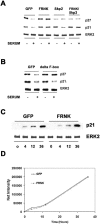
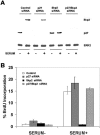
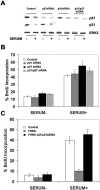
Similar articles
-
FAK in the nucleus prevents VSMC proliferation by promoting p27 and p21 expression via Skp2 degradation.Cardiovasc Res. 2022 Mar 16;118(4):1150-1163. doi: 10.1093/cvr/cvab132. Cardiovasc Res. 2022. PMID: 33839758 Free PMC article.
-
All-trans retinoic acid inhibits mesangial cell proliferation by up-regulating p21Waf1/Cip1 and p27Kip1 and down-regulating Skp2.J Nephrol. 2012 Nov-Dec;25(6):1031-40. doi: 10.5301/jn.5000090. J Nephrol. 2012. PMID: 22344541
-
STAT3 interacts with Skp2/p27/p21 pathway to regulate the motility and invasion of gastric cancer cells.Cell Signal. 2013 Apr;25(4):931-8. doi: 10.1016/j.cellsig.2013.01.011. Epub 2013 Jan 17. Cell Signal. 2013. PMID: 23333463
-
Ubiquitylation and proteasomal degradation of the p21(Cip1), p27(Kip1) and p57(Kip2) CDK inhibitors.Cell Cycle. 2010 Jun 15;9(12):2342-52. doi: 10.4161/cc.9.12.11988. Epub 2010 Jun 15. Cell Cycle. 2010. PMID: 20519948 Free PMC article. Review.
-
p27(Kip1) signaling: Transcriptional and post-translational regulation.Int J Biochem Cell Biol. 2015 Nov;68:9-14. doi: 10.1016/j.biocel.2015.08.005. Epub 2015 Aug 14. Int J Biochem Cell Biol. 2015. PMID: 26279144 Review.
Cited by
-
The differential susceptibilities of MCF-7 and MDA-MB-231 cells to the cytotoxic effects of curcumin are associated with the PI3K/Akt-SKP2-Cip/Kips pathway.Cancer Cell Int. 2014 Nov 30;14(1):126. doi: 10.1186/s12935-014-0126-4. eCollection 2014. Cancer Cell Int. 2014. PMID: 25530715 Free PMC article.
-
The Long Noncoding RNA PRANCR Is Associated with Alternative Splicing of Fibronectin-1 in Keratinocytes.J Invest Dermatol. 2023 Sep;143(9):1825-1830.e6. doi: 10.1016/j.jid.2023.01.038. Epub 2023 Mar 9. J Invest Dermatol. 2023. PMID: 36906126 Free PMC article. No abstract available.
-
Inhibitors of Src and focal adhesion kinase promote endocrine specification: impact on the derivation of β-cells from human pluripotent stem cells.J Biol Chem. 2011 Oct 14;286(41):36042-36052. doi: 10.1074/jbc.M111.290825. Epub 2011 Aug 18. J Biol Chem. 2011. PMID: 21852242 Free PMC article.
-
A paradigm shift: Cancer therapy with peptide-based B-cell epitopes and peptide immunotherapeutics targeting multiple solid tumor types: Emerging concepts and validation of combination immunotherapy.Hum Vaccin Immunother. 2015;11(6):1368-86. doi: 10.1080/21645515.2015.1026495. Hum Vaccin Immunother. 2015. PMID: 25874884 Free PMC article. Review.
-
RHOA-FAK is a required signaling axis for the maintenance of KRAS-driven lung adenocarcinomas.Cancer Discov. 2013 Apr;3(4):444-57. doi: 10.1158/2159-8290.CD-12-0388. Epub 2013 Jan 28. Cancer Discov. 2013. PMID: 23358651 Free PMC article.
References
-
- Abid, M. R., K. Yano, S. Guo, V. I. Patel, G. Shrikhande, K. C. Spokes, C. Ferran, and W. C. Aird. 2005. Forkhead transcription factors inhibit vascular smooth muscle cell proliferation and neointimal hyperplasia. J. Biol. Chem. 280:29864-29873. (First published 15 June 2005; doi:10.1074/jbc.M502149200.) - DOI - PubMed
-
- Alavi, A., J. D. Hood, R. Frausto, D. G. Stupack, and D. A. Cheresh. 2003. Role of Raf in vascular protection from distinct apoptotic stimuli. Science 301:94-96. - PubMed
-
- Assoian, R. K., and M. A. Schwartz. 2001. Coordinate signaling by integrins and receptor tyrosine kinases in the regulation of G1 phase cell-cycle progression. Curr. Opin. Genet. Dev. 11:48-53. - PubMed
Publication types
MeSH terms
Substances
Grants and funding
LinkOut - more resources
Full Text Sources
Research Materials
Miscellaneous
